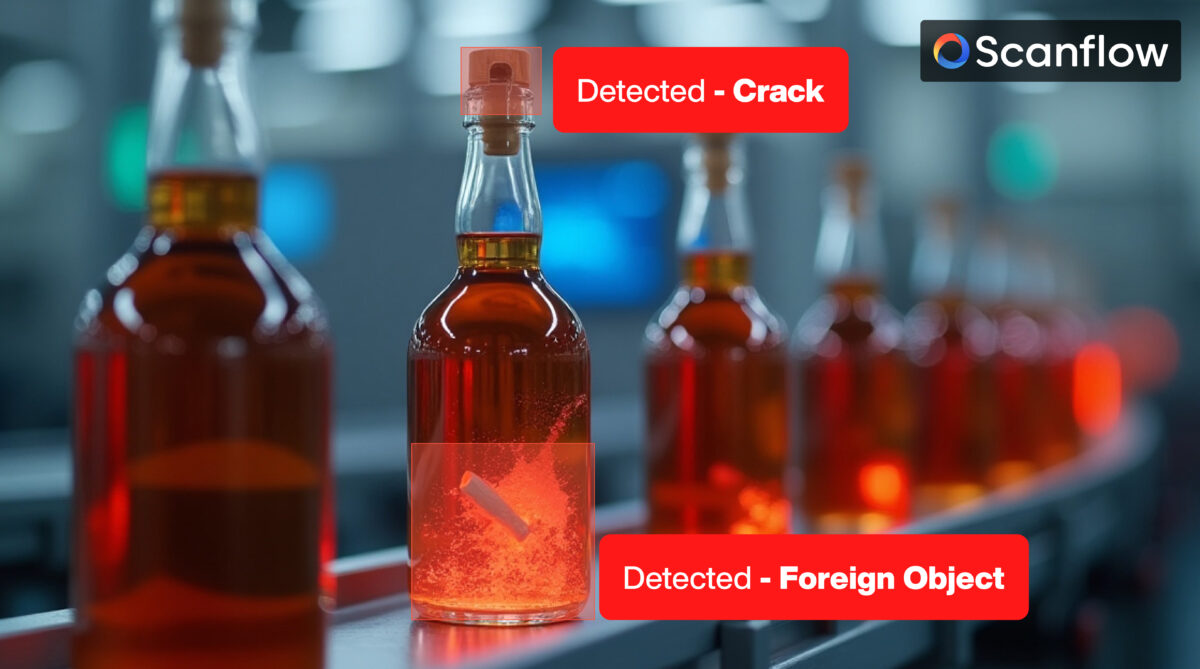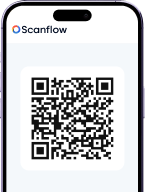In high-speed manufacturing environments, ensuring product quality is essential to maintaining brand integrity and meeting regulatory standards. A leading manufacturer of liquor bottles faced challenges with manual inspection processes, which led to missed foreign particles and misaligned labels. Scanflow partnered with them to implement an automated visual inspection solution, improving both operational efficiency and product quality at the packaging stage.
The Challenge
Key quality control issues at their packaging line:
- Inconsistent Manual Inspections: Manual checks were prone to fatigue and human error, resulting in missed foreign particles and incorrect label placement.
- Labor-Intensive and Time-Consuming: The manual inspection of bottles, including the hard-to-reach areas such as the bottom, was time-consuming and required substantial manpower.
- Difficulty in Detecting Subtle Defects: Small foreign particles, cracks, and label misalignments were difficult to detect manually, especially on opaque or colored bottles.
- Throughput Limitations: Manual processes could not keep up with high-speed production, affecting efficiency and output.
- Inconsistent Quality Across Shifts: Variability in inspection quality from shift to shift and operator to operator led to inconsistent product quality.
How Scanflow Helped
Scanflow deployed its automated visual quality control system, using high-definition cameras to detect foreign particles and verify label orientation on the production line. The system was integrated seamlessly with the existing packaging process, ensuring there were no disruptions.
How It Works
| Capability | Function |
|---|---|
| Foreign Particle Detection | Detects debris, insects, and other foreign particles inside sealed liquor bottles. |
| Label Orientation Inspection | Verifies correct label placement and alignment on bottles after automated labeling. |
| End-of-Line Camera Integration | Utilizes existing IP cameras for capturing real-time images of bottles on the conveyor. |
| Real-Time Defect Detection | Flags defective bottles for immediate rejection from the production line. |
| Data Sync with ERP | Synchronizes inspection data with the client’s ERP system for batch tracking and regulatory compliance. |
- Foreign Particles Detection: Two high-definition cameras capture images of bottles on the conveyor, scanning for foreign particles such as dust, insects, or breakages. If a defect is detected, the system triggers an alarm, stopping the conveyor and allowing operators to manually remove the faulty bottles.
- Label Orientation Inspection: After label application, the system checks if the labels are correctly oriented. Any misalignment triggers an alert, prompting operators to send the bottle to the rework station for correction.
Impact Delivered:
| Impact Area | Before Scanflow | After Scanflow |
|---|---|---|
| Inspection Speed | Manual inspection was slow and prone to errors | Automated inspection sped up the process |
| Product Quality | Inconsistent inspection quality | Increased consistency and fewer defects |
| Operational Efficiency | High labor costs and slower production | Reduced labor, faster throughput |
| Compliance | Inconsistent documentation | Automated data capture for full traceability |
Results Delivered
- Reduced Labor Costs: Automating the inspection process minimized the need for manual labor, resulting in reduced operational costs.
- Improved Product Quality: Scanflow’s system reduced defects by catching errors at the end-of-line, preventing wrongly labeled bottles from reaching consumers.
- Increased Throughput: The automated process allowed for higher production rates, without compromising quality.
- Regulatory Compliance: Digital logs of inspection results were automatically recorded, ensuring full traceability and adherence to industry regulations.
Final thought
In industries like liquor packaging, in-line quality inspection is critical to ensuring that each product meets the required standards. Labeling errors or incorrect label placement can lead to regulatory violations, product recalls, and potential consumer safety issues. By replacing manual inspection with automated visual inspection, Scanflow helped Tilak Nagar Industries enhance their quality control during the production line, ensuring products are packaged correctly and meet all regulatory requirements.
Scanflow’s solution proves that automated defect detection and label orientation verification during in-line inspection are essential for maintaining operational efficiency, product integrity, and compliance in high-speed manufacturing environments.
Interested in learning how Scanflow can improve your in-line packaging quality control?
Contact us now


